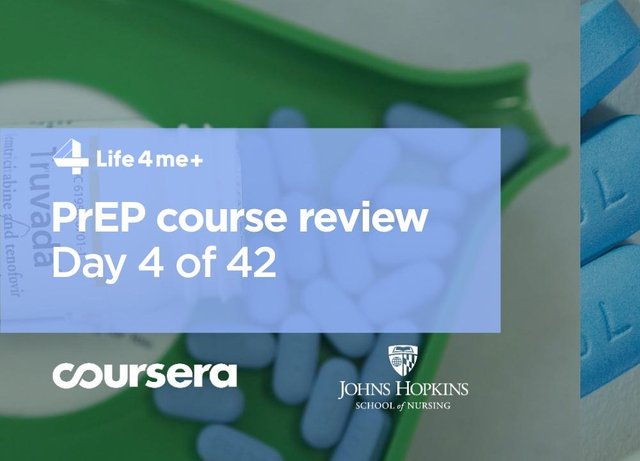HIV Pre-Exposure Prophylaxis (PrEP) Online Course at Coursera Review. Day 4 of 42.

Today we will talk about the lecture «PrEP Demonstration Projects» read by Chris Beyrer, professor of epidemiology at Bloomberg School of Public Health at Johns Hopkins University.
Professor Beyrer started the lecture with the question
«Is it possible to achieve a complete control of the HIV epidemic?»
He considered options for answering this question on the graph where HIV incidence with different approaches to control the outbreak was analyzed. Next, the lecturer explained the work of Cremlin and the authors in the AIDS Journal (2013), we he looked at the predictions of HIV incidence per 100 person-years based on mathematical modeling without intervention and with such interventions as:
- assignment to 100% of patients with ART at a CD4 count of 200 cells;
- circumcision;
- early administration of ART immediately after diagnosis;
- PrEP and behavioral strategies;
It is worth explaining the meaning of the wording «the occurrence of HIV in the calculation for 100 person-years.» It’s a kind of mathematical generalization to simplify the comparison of data that is obtained from different studies — they observe subjects of different ages, the duration of the studies is also different. It is necessary to bring the data to a single scale for an adequate comparison.
So, if the HIV incidence was 4 per 100 person-years, then in the next year four people out of 100 will become HIV-positive.Dr. Beyrer showed that such HIV incidence fell in the «without intervention» series — «PrEP and behavioral strategies,» confirming the hypothesis that providing of PrEP in the risk groups leads to a decrease in HIV transmission and slows down the epidemic.
Next, the lecturer drew attention to the adherence to taking tablets during PrEP in participants. Often, adherence was low, particularly in transgender women.Another EPIC-NSW study began in March 2016 in the United States. 3,700 volunteers from high-risk groups suggested taking PrEP. Of these, 900 people agreed to the study in the first nine weeks.
A series of studies of PrEP in Thailand in 2015-2016 showed levels of voluntary involvement of participants in the PrEP research programs, at the level of 44% — 60%. Also, since early 2016, Thailand has a Princess program in Thailand that provides PrEP free of charge to at-risk groups such as MSM and transgender men and women. The involvement in the program in the first months was 10%, whereas the three-year program is designed to involve 3,000 participants.Another exciting program is a joint project of the Johns Hopkins University, Emory University and the Ministry of Health of Thailand COPE4YMSM, which studies the combined tactics of preventing the spread of HIV among young MSM aged 18-26. It’s not a clinical efficacy study, but an example of a PrEP demonstration project, which became a model of providing PrEP into risk groups. Before the beginning of the research, scientists developed a diagnostic method and rules for including participants in a demonstration project that would allow such a project to be carried out with practical results.
In the COPE4YMSM study, the investigators analyzed the effectiveness of PrEP along with the cost-effectiveness of interventions. They designed to recruit two groups of tested young MSM without HIV, for 620 people in each. In the one group, PrEP planned to be assigned, and the other group is monitored without the provision of PrEP. The recruitment of the participants took place at the rapid HIV testing and sexually transmitted infection testing centers. A method of attracting subjects — outreach programs and activities in institutions for MSM (gay clubs and others). The inclusion criterion was the absence of HIV and other infections in MSM aged 18-26. The participant, if approached by criteria and signed an informed consent to the study, was included in a random group — with PrEP or without PrEP. The consultants also distributed free condoms and talked about risk reduction programs with all people involved in the program activity. Professor Beyrer was the scientific leader of this study.
Feedback to monitor adherence to PrEP and informational support was designed in the form of SMS chats. An additional goal of the project was to analyze and describe the connection between the participation of young MSM as sex workers with the risk of getting HIV. As a result, the researchers desired to understand the cumulative cost of the PrEP programs and to calculate the economic effect on savings on future costs of HIV treatment. The fewer people with HIV will be in the country, the lower the future costs of treatment will be expected by the budget of this country.The study is still ongoing, but Chris is ready to share his observations:
- Among MSM, the maximum risk of getting HIV in small intervals of life;
- Some men use PrEP for a limited time;
- 40% of young MSM (18-26 years old) in Thailand periodically provide sex services and do not identify themselves as sex workers.
Are you interested in learning more about the results of the program? Remember the name, COPE4YMSM, and follow the news.
See you next tomorrow and don’t forget to enroll for the course at https://www.coursera.org/learn/prep if you interested in it!
Stay with us!
P. S. The original article was posted on the Life4me+ mobile app for HIV-positive persons blog.